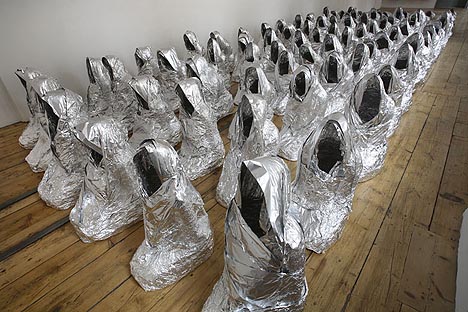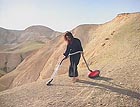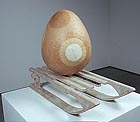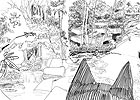
translated and summarized by: Liz Wollner-Grandville,
English summary April 1 - 5
Saatchi Gallery: Unveiled: New Art from the Middle East
The new in the limelight
Last October, Charles Saatchi opened his new gallery in Chelsea with the exhibition “The Revolution continues: New Chinese Art”. Currently, “Unveiled: New Art from the Middle East” is being shown, which will be followed by “Abstract America: New Painting and Sculpture” and “Germania: New Art from Germany”. Contrary to the trend of increasing globalisation, hyper-mobility, as well as transnationality, the individual presentations focus on regional aspects – and do not shun away from the complexity of Middle East problems.
The show begins with works by the Lebanese artist Marwan Rechmaoui, who lives in Boston. The black Indian rubber mat “Beirut Caoutchouc” (2004 – 2008) displays tiny ingrained details - the physical and social formation of an urban landscape. Destruction and the long history of conflict are not presented directly, but indirectly through the material chosen. In his colourful walk-in installation Future City “Qalandia 2067”, the Palestinian artist Wafa Hourani presents the possible urban texture of a refugee camp with details including toy cars, graffiti, or cacti in flower pots made of bullet casings. Even in the year 2067, he envisages a dividing wall ( with American advertisment banners) to an Israeli military airport.
The role of women in today’s Iran is the focal point of Shadi Ghadirian’s work. In her photographical work “Untitled from the Ghajar Series” (1998 – 1999) anachronistic requisites such as a vacuum cleaner or a ghetto blaster irritate the portraits originating from the 19th century, which are emulated in great detail. Questions regarding the positioning of women in the Iranian society are raised through the model’s unusual poses, evoked by the objects. The unofficial Iran is represented by Shirin Fakhim’s life size grotesque sculptures made of kitchen utensils, western prostitutes-outfits and encoded Islamic objections including a chastity belt or a headscarf. “Tehran Prostitute” (2008) stereotypes a picture in the public and prejudiced opinions: In public, Muslim prostitutes wear a Hijab (veil). Humour as a method is also manifested in Tala Madani’s bizarre and surreal paintings, in which male behaviour point to complex political and cultural topics in the Islamic culture in stereotypical glory.
The works do not attempt to communicate via high-tech-gimmicks, participatory strategies or documentary narratives, but through monumental formats and large, poetic gestures. However, the exhibition risks to conceal more than it reveals, and to appear superficial by presenting the works of 19 internationally renowned artists from the region (Iran, Iraq, Egypt, Tunisia, Lebanon, Syria, and Algeria). General topics are prioritized: gender roles, religious conflicts, destruction as a consequence of violence, and the westernization of society.
By Margit Neuhold
Saatchi Gallery
SW3 4SQ London, Duke of York’s HQ King’s Road, until 09.05.09
www.saatchi-gallery.co.uk
Zentrum Paul Klee: Dream and Reality. Contemporary Art from the Middle East
Vacuum-clean the desert
It strikes one as somewhat absurd to speak of contemporary art from Middle East countries or the Orient as many of the invited artists, among them Walid Raad or Lida Abdul have not lived there for a long time. The artists’ work is predominantly determined by their critical relationship to their home country and the interaction between numerous cultures. This is also valid for works by the Swiss artists San Keller or Reto Leibundgut. They spent some time in Cairo as artists-in-residence. The Zentrum Paul Klee is therefore not presenting work from the Middle East, but about the Middle East.
There are only a few exceptions, among them Shirin Neshat’s photos, in which the artists avoid clichés and pathos. The works confront glorification with alert and satirical comments. The protagonist in Raeda Saadeh’s videos, dressed in a black chador, vacuum cleans a desert landscape. A similar tragic-comic situation is shown in the video “The Work by Sener Özmen”, in which women pursue a Sisyphean task: what at first looks like they are concentrating on skilled handicraft turns out to be the pointless squashing of bubble wraps.
Some works focus on the cruelties of the ongoing conflicts and are visualized with media of fictionalisation: through desires, wishes, and longing, which break out under the political and social circumstances. The artistic confrontation in this exhibit mainly takes place with video and photography.
All of the works can be watched while sitting in one of the numerous plastic chairs, some of which offer the highly recommendable audio stations designed by the Bernese music technologist Thomas Burkhalter. However, the superfluous displays showing so-called “everyday objects from the Orient of the 20th century” and the sand dune colouring of the walls constitute a contradictory indoctrination; a rather questionable effect.
By Marianne Wagner
Zentrum Paul Klee
3006 Bern, Monument im Fruchtland 3, until 16.08.09
www.paulkleezentrum.ch
Galerie Ernst Hilger: Jiri Kolár – Objects and Collages
Egg on a sled
It remains to be contested if Jirí Kolár (1914 – 2002) was actually the “principal Czech artist of the 20th century”, as stated in the Gallery Hilger press release. Artists such as Frantisek Kupka, Karel Capek, Antonín Procházka, Toyen, Milan Knizak and Jirí Kovanda are definitely also among the most outstanding Czech artists.
In any case: Kolár’s assemblages and collages from the 1980s presented at this exhibition are impressive. In the relief “Portrait de Pierre Alechinsky” he lets faraway places bump into one another. This continental drift is caused by atlas clippings mounted delicately next to one another, whereby Istanbul is suddenly found next to Cassis. Kolár also has a foible for star charts, internal organs or colourful wings: they decorate fences, obelisks or a bowl with a head, or stabilize a composition. Kolár glues paper money onto a duck, lets an egg take a sled ride, and hangs a sleeveless shirt over a fence.
Besides Kolar’s obviously surrealistic compositions his dealing with language attracts attention: oftentimes his compositions include cuttings from French books, and he enjoys including Arabic or Chinese characters; even Braille is used in his three-dimensional worlds.
It may well be that his oeuvre, considering the era in which they were created, seem a bit retro: after the end of the historic Avant-garde only very few artists devoted themselves to collages, at least in their traditional form, using paper, scissors, and glue instead of a scanner and Photoshop. But this does not harm their symbolic mysteriousness, which in turn provokes another controversy.
By Nina Schedlmayer
Galerie Ernst Hilger
1010 Vienna, Dorotheergasse 5, until 23.04.09
www.hilger.at
Startgalerie im Museum auf Abruf: Markus Dressler – French, music and washing extra
In the wide world of a quote
“Postmodern” is a perfect description of Markus Dressler’s (born 1969) oeuvre. Quotes from comics, photos of graffiti, videos, installations, pictures, and drawings are positioned next to one another - with no conclusive connection. Classic literature quotes as well as pop culture are dealt with in a playful manner. A CD of Markus Dressler’s music project with his own graphical design is presented next to drawings of the Guggenheim Museum in New York. Frank Lloyd Wright, the Guggenheim architect, emerges a second time with his Fallingwater House, which he built in 1935 for the department store owner Edgar J. Kaufmann. Cats are depicted in most of his works.
This seeming randomness develops an ease, which can be perceived as a virtue or as a flaw. After all, it is a question of interpretation if and how much sense one wants to see in this colourful universe, or if one is actually searching for any sense. Undoubtedly, he is a talented illustrator with a witty sense of humour, as his “Fallingwater Nose”, which reminds of Wright’s “Fallingwater House”, plays skilfully with quotes from art and everyday life. The drawing of the Guggenheim Museum is an amazingly reduced architectural sketch, displaying the overwhelming beauty of the building, as well as the artist’s style.
In this world full of cross-references and quotes the visitor understands what could be meant by the term “postmodern”, and the multitude of the different motifs and techniques allows everyone to easily find something that appeals to him/her.
By Wolfgang Pichler
Startgalerie im Museum auf Abruf
1010 Vienna, Felderstrasse 6-8, next to the Town Hall, until 16.04.09
www.musa.at
Saatchi Gallery, Zentrum Paul Klee, Galerie Ernst Hilger, Startgalerie im Museum auf Abruf
Mehr Texte von translated and summarized by: Liz Wollner-Grandville


 Teilen
Teilen





